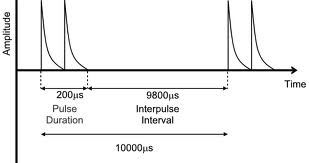

Notes
Impulspause: Die Impulspause in der Elektronik bezeichnet die Zeitspanne zwischen dem Ende eines Impulses und dem Beginn des nächsten Impulses in einer Impulsfolge. Es ist die "Aus-Zeit" oder die Periode der Inaktivität zwischen aufeinanderfolgenden Impulsen.
interpulse interval: In electronics, the interpulse interval (IPI) refers to the time duration between the end of one pulse and the beginning of the next pulse in a sequence of pulses. It's essentially the "off-time" or the period of inactivity between consecutive pulses.
Definition: The interpulse interval is a temporal parameter that describes a pulsed waveform. It's measured from the end of the last phase of one pulse to the beginning of the first phase of the next pulse.
Relationship with Pulse Repetition Frequency (PRF): The interpulse interval (IPI) and the pulse repetition frequency (PRF) are inversely related. The PRF is the number of pulses that occur per unit of time (usually per second), while the interpulse interval is the time between consecutive pulses.
PRF = 1/Pulse Repetition Time (PRT)
PRT = Pulse Duration + Interpulse Interval
A higher PRF means a shorter pulse repetition time, which implies either a shorter pulse duration, a shorter interpulse interval, or both. Conversely, a longer interpulse interval will result in a lower PRF, assuming the pulse duration remains constant.
Would you like to see a description of pulse intervals with an image and legend in German?
Go to the main instrumentation glossary >> in German and English
.